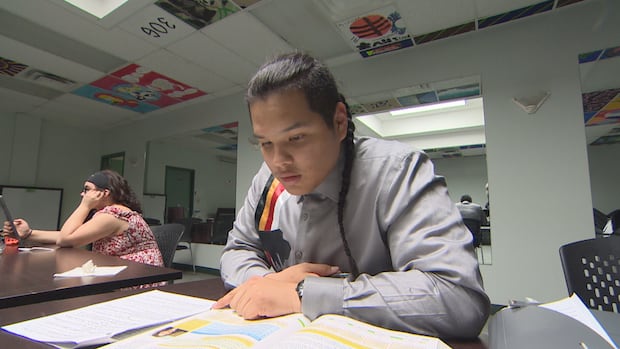Saskatoon program helping Indigenous students thrive in high school and beyond
Pathways to Education offers more than just tutoring, it feels 'like going home to my family,' student says
As Rylan Iron gets ready to graduate from Holy Cross High School in Saskatoon, the 18-year-old is already planning for a busy future, including three years of post-secondary school at the University of Saskatchewan in Indigenous studies.
After that, he hopes to go "somewhere nice" to study Indigenous-centred law.
Getting here has taken a lot of hard work. Originally from Canoe Lake Cree First Nation, he says he may not have made it without the Pathways to Education Program, an after-school tutoring program that offers academic help and much more.
"It really just felt like I was going home to my family," Iron said. "It's a wonderful experience."
Pathways to Education is a national charitable organization that operates in 31 communities. It helps break the cycle of poverty through education, by providing after-school tutoring and other community specific supports to students.
According to Statistics Canada, Indigenous students are less likely to complete high school (63 per cent) than non-Indigenous students (91 per cent).
In Saskatchewan, the program works with the Saskatoon Tribal Council and the Gabriel Dumont Institute, which allows students to access wraparound resources including food, bus passes, school supplies and culturally relevant activities.
The students and their families also receive sports mentorship, housing help, access to mental health services and job readiness programs.
Students can sign up for the program in Grade 9, and when they graduate they receive a $2,000.
In Saskatoon, 350 Métis and First Nations students from nine public and five Catholic schools across the city are currently enrolled.
Darlene Lanceley, the tribal council's Pathways to Education manager, said the Saskatoon program is stands out for including First Nations and Métis culture both inside and outside of the classroom.
"So in the summertime, for example, we'll take them to powwows," Lanceley said. "We take them to the round dance with the horse dance. We take them medicine picking, so they actually learn how to pick the sage and how to do things with the sage and sweetgrass."
Lanceley said the program is making a significant difference, not only to graduation rates, but also to the students' confidence and potential.
"I motivate them because I tell them that they're smart," Lanceley said. "I tell them that they're courageous. I tell them that they're resilient. I tell them things that a lot of people don't say to Indigenous youth."
It was Lanceley who inspired Iron to join the program in Grade 9, when she offered him some pizza during a recruiting session at his school.
The free pizza may have brought him through the door, but having a welcoming place to hang out, make new friends and get help with his homework kept him coming back for four years.
"As much as education is really important, you also must not forget that cultural sense of being Indigenous," Iron said. "Even with the medicine wheel, they say you have to find balance, right? So in order to keep that balance, you must maintain a good mental, physical, spiritual and emotional level."

Pathways operates from 4 p.m. to 7 p.m. The kids get fed supper and also receive a weekly voucher for lunch at their own school.
In Saskatoon, the program operates out of the White Buffalo Youth Lodge, with access to a large gymnasium, a weight room, a computer lab, a craft room and a room for ceremonies, smudging and prayers.
"You could definitely be feeling stressed, then all of a sudden … when you smudge or when you eat or when you when you talk with your friends there, it really kind of brings your stress down," Iron said.
Winona McLean is also about to graduate from Saskatoon's Bedford Road Collegiate and from the Pathways Program.
The 17-year-old is from James Smith Cree Nation and also has family on Piapot. McLean said being in Pathways has helped her gain confidence and life skills.
"It's definitely made like a huge difference," McLean said. "Without them, I don't think I'd even be graduating this year because I really struggled in math and science."
McLean's mother encouraged her to join Pathways in Grade 9. Now, at the upcoming ceremony for this year's 60 graduates, she will be the valedictorian.
"She's very proud, I think," McLean said. "She's very happy that I'm graduating because she didn't have a really good experience in high school."
From a cultural perspective, McLean also appreciates being in a place where her Indigenous roots are respected.

All of these elements make a big impact, according to Lanceley, who grew up in Prince Albert. She said it's helping narrow the high school graduation gap between Indigenous and non-Indigenous students.
"These are Indigenous students and they're graduating on time, which is important," Lanceley said. "When I was in high school, nobody cared. I remember the principal saying, 'Why are you trying to graduate? Don't you know Indians don't graduate?'"
Iron is grateful for the opportunities the program has given him. He said he hopes he can use his experiences to inspire others.
"Especially when you have a lot of family back home on the reserve who don't have the same opportunity as you, it's like, you're really speaking for them," Iron said. "I hope I can keep giving back and hopefully one day, become like an influential person."


